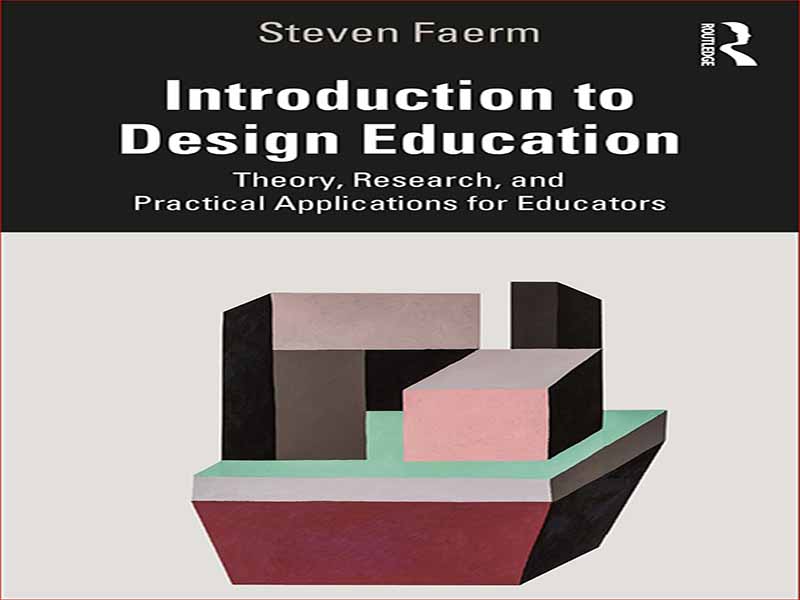- عنوان کتاب: Introduction to Design Education
- نویسنده: Steven Faerm
- حوزه: آموزش طراحی
- سال انتشار: 2022
- تعداد صفحه: 324
- زبان اصلی: انگلیسی
- نوع فایل: pdf
- حجم فایل: 6.95 مگابایت
“نگران نباش، خودت متوجه میشی.” در اواخر دهه 1990، زمانی که برای اولین بار به عنوان یک مربی وارد کلاس طراحی شدم، مدیر استخدامم به من اطمینان داد که به زودی نحوه تدریس را “پیدا خواهم کرد”. من نیز مانند بسیاری از ما، تجربیات حرفه ای زیادی به عنوان طراح داشتم، بنابراین فرض بر این بود که می توانم طراحی تدریس کنم. با تشریفات کمی، من را در کلاسی قرار دادند که اساساً هیچ آموزش آموزشی یا بینش استادی در مورد رشد دانش آموزان نداشت. از طریق آزمون و خطا، دوره به دوره، و ترم به ترم، من به “پیدا کردن آن” رها شدم. “آموزش خوب” چیست؟ بیش از دو دهه پس از تدریس اولین دوره، من هنوز تعریف دقیقی از «تدریس» ندارم. بلکه همانطور که ضرب المثل می گوید: “هر چه بیشتر بدانید، بیشتر می دانید که نمی دانید.” تجربه چندین دهه کار من با هزاران دانش آموز از سطوح مختلف دانشگاهی، ایفای نقش های متنوع در سمت های رهبری و مشاوره دانشگاهی، سخنرانی در پنج قاره در بیش از چهل موسسه، تکمیل دو مدرک پیشرفته در آموزش و سپس درک آن همه – مرا وادار کرده است که در مورد اینکه «آموزش عالی» چیست و «آموزگار» بودن واقعاً به چه معناست، انتقادیتر فکر کنم. معانی این اصطلاحات بسیار پیچیدهتر از آن چیزی است که من قبل از شروع سفرم به عنوان یک مربی طراحی تصور میکردم. تجارب و تأملات من در این سفر مرا متوجه این واقعیت کرده است که ما به عنوان مربیان طراحی باید اولویت بسیار بیشتری نسبت به قبل به پیشبرد و تقویت شیوه های تدریس خود بدهیم. اگر این کار را نکنیم خیلی در خطر است. بنابراین، من شدیداً امیدوارم که مقدمه ای بر آموزش طراحی: تئوری، تحقیق و کاربردهای عملی برای مربیان، دانش، بینش و مهارت هایی را برای مربیان طراحی فراهم کند که برای پیشبرد شیوه های آموزشی خود نیاز دارند. این کتاب، اولین کتاب در نوع خود، به خوانندگان – از جمله مربیان طراحی، مدیران و محققان – درک درستی از صنایع طراحی در حال تغییر و همچنین چگونگی و چرایی پاسخگویی آموزش طراحی در ایالات متحده ارائه میکند. از طریق ارائه تحقیقات گسترده، تئوری، و راهبردهای آموزشی عملی، این متن، آموزش طراحی را با رشد دانشآموزان مرتبط میکند. من قویاً معتقدم که این زمینهسازی یک مؤلفه حیاتی برای تقویت آموزش موفق، یادگیری بهینه و موفقیت دانشآموز است. آموزش طراحی در ایالات متحده به تغییرات چشمگیر صنایع طراحی با برنامه های درسی تکامل یافته پاسخ می دهد. به طور سنتی، این برنامههای درسی بر مهارتهای حرفهای تأکید میکردند، اما اکنون با برنامههایی جایگزین میشوند که توسعه تفکر مفهومی، بین رشتهای و فرآیندهای طراحی نوآورانه دانشآموزان را در اولویت قرار میدهند. ساختارهای برنامه، دورههای آموزشی، و ارائههای مدرک برای پاسخگویی به خواستههای جدید یک صنعت شتابزده و شتابزده مجدداً تصور میشوند تا فارغالتحصیلان و متخصصان جوان با تکامل شیوههای طراحی حرفهای و تفکر طراحیشان شکوفا شوند. همزمان، جمعیت دانشجویی جدیدی وارد پردیسهای مدرسه طراحی میشوند. این جمعیت رو به رشد از دانشجویان کارشناسی طراحی – بزرگترین آنها تا کنون – سبک های یادگیری، اهداف شخصی و حرفه ای، دیدگاه های آموزش عالی و نیازهای توسعه را به طور قابل توجهی نسبت به گروه های قبلی متفاوت نشان می دهند. ویژگیهای منحصربهفرد آنها، همراه با تغییرات در صنایع طراحی و آموزش، برای مربیان ضروری است که آموزشهای آموزشی خود را پیش ببرند و استراتژی خود را به گونهای که دانشجویان طراحی، مؤسسات، فارغالتحصیلان و صنایع آنها شکوفا شوند.
“Don’t worry, you’ll figure it out.”
In the late 1990s, when I first entered the design classroom as an edu¬cator, my hiring director assured me I’d soon “figure out” how to teach. Like many of us, I had vast professional experiences as a designer, so it was assumed I could teach design. With little ceremony, I was placed in a classroom with essentially no pedagogical training or any professorial insight into student development. Through trial and error, course after course, and semester after semester, I was left to “figure it out.”
What is “good teaching?” Over two decades after teaching that first course, I still don’t have a precise definition of what “teaching” is; rather, as the adage goes, “The more you know, the more you know you don’t know.” My decades of experience working with thousands of students from across academic levels, holding diverse roles in aca¬demic leadership and advisorship positions, lecturing across five con¬tinents at over forty institutions, completing two advanced degrees in education—and then making sense of it all—has made me think more critically about what constitutes “great teaching” and what being an “educator” really means.
The meanings of these terms are far more complex than I ever imagined prior to setting out on my journey as a design educator. My experiences and reflections on this journey have awakened me to the fact that we, as design educators, must give far greater priority to advancing and strengthening our teaching practices than we have before. There is just too much at stake if we don’t. Thus, I ardently hope that Introduction to Design Education: Theory, Research, and Practical Applications for Educators provides design educators with the knowledge, insights, and skills they need to advance their pedagogical practices.
This book, the first of its kind, provides readers—including design educators, directors, and scholars—with an understanding of the shift¬ing design industries as well as how and why design education in the US is responding. Through the presentation of extensive research, theory, and practical instructional strategies, the text contextualizes design ped¬agogy with student development. I strongly believe this contextualization is a critical component of fostering successful teaching, optimal learn¬ing, and student success.
Design education in the US is responding to the dramatically chang¬ing design industries by evolving curricula. Traditionally, these curricula have emphasized vocational skills, but they are now being replaced with those that prioritize the development of students’ conceptual thinking, interdisciplinarity, and innovative design processes. Program structures, coursework, and degree offerings are being reimagined to meet the new demands of an increasingly tenuous, accelerated industry so that grad¬uates and young professionals may flourish as their professional design practices and their design thinking evolve.
Concurrently, a new student population is entering design school cam¬puses. This growing population of design undergraduates—the largest ever—exhibits markedly different learning styles, personal and profes¬sional goals, views of higher education, and developmental needs than the preceding cohorts. Their unique attributes, coupled with the shifts in design industries and education, make it essential for educators to advance and strategize their pedagogy so that their design students, institutions, alumni, and industries can flourish.
این کتاب را میتوانید از لینک زیر بصورت رایگان دانلود کنید:
Download: Introduction to Design Education



































نظرات کاربران